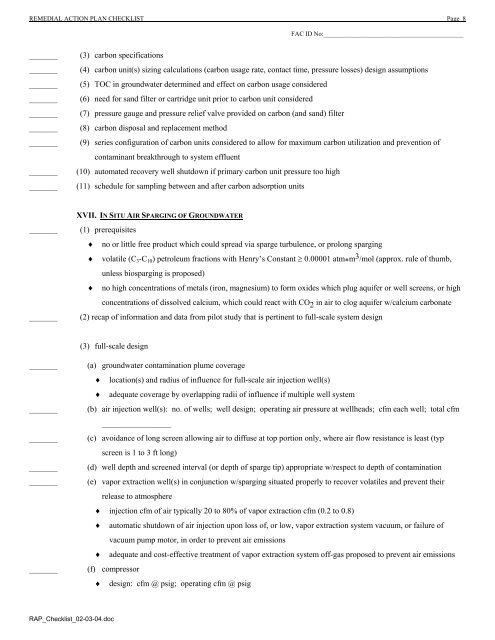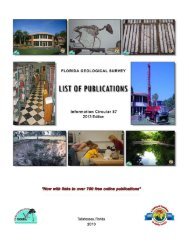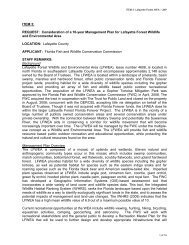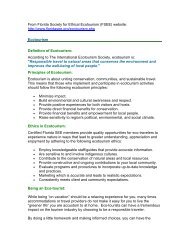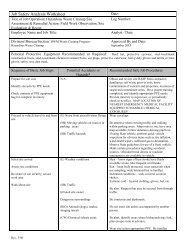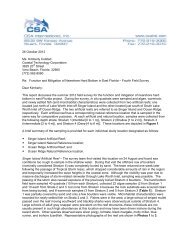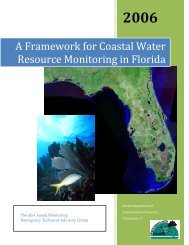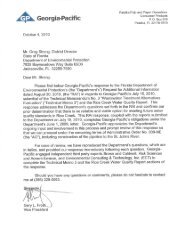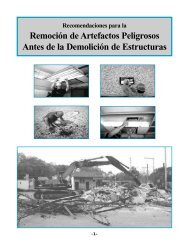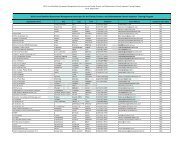Remedial Action Plan checklist - Florida Department of ...
Remedial Action Plan checklist - Florida Department of ...
Remedial Action Plan checklist - Florida Department of ...
Create successful ePaper yourself
Turn your PDF publications into a flip-book with our unique Google optimized e-Paper software.
REMEDIAL ACTION PLAN CHECKLIST Page 8<br />
RAP_Checklist_02-03-04.doc<br />
FAC ID No:___________________________________________<br />
_______ (3) carbon specifications<br />
_______ (4) carbon unit(s) sizing calculations (carbon usage rate, contact time, pressure losses) design assumptions<br />
_______ (5) TOC in groundwater determined and effect on carbon usage considered<br />
_______ (6) need for sand filter or cartridge unit prior to carbon unit considered<br />
_______ (7) pressure gauge and pressure relief valve provided on carbon (and sand) filter<br />
_______ (8) carbon disposal and replacement method<br />
_______ (9) series configuration <strong>of</strong> carbon units considered to allow for maximum carbon utilization and prevention <strong>of</strong><br />
contaminant breakthrough to system effluent<br />
_______ (10) automated recovery well shutdown if primary carbon unit pressure too high<br />
_______ (11) schedule for sampling between and after carbon adsorption units<br />
XVII. IN SITU AIR SPARGING OF GROUNDWATER<br />
_______ (1) prerequisites<br />
♦ no or little free product which could spread via sparge turbulence, or prolong sparging<br />
♦ volatile (C3-C10) petroleum fractions with Henry’s Constant ≥ 0.00001 atm * m3 /mol (approx. rule <strong>of</strong> thumb,<br />
unless biosparging is proposed)<br />
♦ no high concentrations <strong>of</strong> metals (iron, magnesium) to form oxides which plug aquifer or well screens, or high<br />
concentrations <strong>of</strong> dissolved calcium, which could react with CO2 in air to clog aquifer w/calcium carbonate<br />
_______ (2) recap <strong>of</strong> information and data from pilot study that is pertinent to full-scale system design<br />
(3) full-scale design<br />
_______ (a) groundwater contamination plume coverage<br />
♦ location(s) and radius <strong>of</strong> influence for full-scale air injection well(s)<br />
♦ adequate coverage by overlapping radii <strong>of</strong> influence if multiple well system<br />
_______ (b) air injection well(s): no. <strong>of</strong> wells; well design; operating air pressure at wellheads; cfm each well; total cfm<br />
_________________<br />
_______ (c) avoidance <strong>of</strong> long screen allowing air to diffuse at top portion only, where air flow resistance is least (typ<br />
screen is 1 to 3 ft long)<br />
_______ (d) well depth and screened interval (or depth <strong>of</strong> sparge tip) appropriate w/respect to depth <strong>of</strong> contamination<br />
_______ (e) vapor extraction well(s) in conjunction w/sparging situated properly to recover volatiles and prevent their<br />
release to atmosphere<br />
♦ injection cfm <strong>of</strong> air typically 20 to 80% <strong>of</strong> vapor extraction cfm (0.2 to 0.8)<br />
♦ automatic shutdown <strong>of</strong> air injection upon loss <strong>of</strong>, or low, vapor extraction system vacuum, or failure <strong>of</strong><br />
vacuum pump motor, in order to prevent air emissions<br />
♦ adequate and cost-effective treatment <strong>of</strong> vapor extraction system <strong>of</strong>f-gas proposed to prevent air emissions<br />
_______ (f) compressor<br />
♦ design: cfm @ psig; operating cfm @ psig


